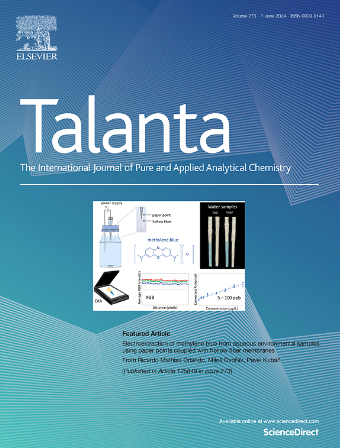Reliable and specific biosensing on single- and double-stranded aptamer functionalized remote dual-gate organic field-effect transistors: A comparison
IF 5.6
1区 化学
Q1 CHEMISTRY, ANALYTICAL
引用次数: 0
Abstract
Organic field-effect transistors (OFETs) integrated with commercial transistors are promising sensing platforms characterized by enhanced device uniformity, functional diversity, and electrical output stability. Aptamers with charged backbones and a high affinity for target molecules are anticipated to mitigate the limitations imposed by Debye screening in physiological environments with high ionic strength, thereby facilitating specific biological recognition in complex surroundings. This study presents two reliable OFET aptasensors for vascular endothelial growth factor (VEGF) and offers a systematic comparison of their performance. The poly[3-(3-carboxypropyl) thiophene-2,5-diyl] (PT-COOH) transducer films on remote dual gates were functionalized with VEGF aptamer (VEap), either alone or in conjunction with its complementary single-stranded DNA (PT-VEap vs. PT-VEap/CS). The single-stranded and double-stranded aptamer-based sensors exhibited opposite changes in threshold voltage in response to VEGF, and the contribution of CS pairing to signaling was evidenced by the lower detection limit of PT-VEap/CS sensors (0.1 ng/mL) compared to that of PT-VEap sensors (1 ng/mL). PT-VEap sensors demonstrated a faster response, while PT-VEap/CS sensors provided more stable and reliable signals. Both sensors maintained high sensitivity to VEGF across a broad pH range (5–9) and ionic strength (0.05–1.0 × PBS), with a slight advantage for PT-VEap in pH resistance and for PT-VEap/CS in salt resistance. The observed differences in sensing performance can be elucidated through the field effect and double electrical layer models. Additionally, the real-time responses and specific molecular recognition of VEGF were analyzed. This study quantifies the differences between single- and double-stranded aptamer-functionalized OFET biosensors, providing foundational data for the design of cost-effective and high-performance FET aptasensors applicable in various real-world scenarios.

求助全文
约1分钟内获得全文
求助全文
来源期刊

Talanta
化学-分析化学
CiteScore
12.30
自引率
4.90%
发文量
861
审稿时长
29 days
期刊介绍:
Talanta provides a forum for the publication of original research papers, short communications, and critical reviews in all branches of pure and applied analytical chemistry. Papers are evaluated based on established guidelines, including the fundamental nature of the study, scientific novelty, substantial improvement or advantage over existing technology or methods, and demonstrated analytical applicability. Original research papers on fundamental studies, and on novel sensor and instrumentation developments, are encouraged. Novel or improved applications in areas such as clinical and biological chemistry, environmental analysis, geochemistry, materials science and engineering, and analytical platforms for omics development are welcome.
Analytical performance of methods should be determined, including interference and matrix effects, and methods should be validated by comparison with a standard method, or analysis of a certified reference material. Simple spiking recoveries may not be sufficient. The developed method should especially comprise information on selectivity, sensitivity, detection limits, accuracy, and reliability. However, applying official validation or robustness studies to a routine method or technique does not necessarily constitute novelty. Proper statistical treatment of the data should be provided. Relevant literature should be cited, including related publications by the authors, and authors should discuss how their proposed methodology compares with previously reported methods.
 求助内容:
求助内容: 应助结果提醒方式:
应助结果提醒方式:


